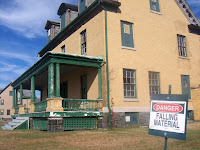Thanksgiving in my family has never been a huge event -- just the parents, my sister and me, with the rare guest (I think I might have invited the college boyfriend once or twice). In fact, it's one of the things I'm thankful for most of the time. Very little stress is involved, unless my mom gets caught up in something she absolutely has to try for the first time, and it doesn't work out. The rest of us don't really care. For the most part, we're all just happy enough to get the standard meal and relax with each other.
Growing up, I felt that we were kind of abnormal in that we didn't have a million people over, or that we didn't all go to my grandmother's house for a big gathering. Somehow, it didn't seem quite American for it just to be us four, in our own house, no guests, but as I got older, I started seeing the wisdom of it. I could never figure out why it is that so many people (women, mostly, I've observed) have to make everything perfect and declare the whole day ruined if the cranberry sauce comes out runny or someone forgets to bring something. Isn't the whole point supposed to be around gratitude and togetherness?
That's not to say we didn't have our unusual aspects -- things that really would have made us weird. When I was 10 or 11 years old, my father took the wall oven out of the kitchen. I think he said there was a gas leak or something, but the bottom line was that he deemed it unsafe. That left a big, gaping hole in the wall, and true to my mom's chronic procrastination, the hole never got filled with a new oven. She had grand ideas about redoing the kitchen, and to this day, there's no oven and a decor that could be the tableau of a Smithsonian exhibit about Eisenhower-era suburban life.
After a bit, the parents bought a combination microwave/convection oven which did a nice job of cooking a turkey, albeit spinning on a carousel in an oven on a microwave cart. It was the period between the gas oven's departure and the advent of residential nukers that created the issue.
My parents were big fans of the Weber grill, the
 kettle-like structure that was noted for being a true revolution in traditional backyard cooking. The neighborhood kids thought it looked weird, compared with their parents' traditional grills, but my dad, ever the scientific thinker, knew better. The shape and lid of the Weber would more evenly distribute heat from the charcoal, as air circulation could be more ably controlled by vents in the lid and kettle. He was truly a man ahead of his time, or at least ahead of the Luddites down the street.
kettle-like structure that was noted for being a true revolution in traditional backyard cooking. The neighborhood kids thought it looked weird, compared with their parents' traditional grills, but my dad, ever the scientific thinker, knew better. The shape and lid of the Weber would more evenly distribute heat from the charcoal, as air circulation could be more ably controlled by vents in the lid and kettle. He was truly a man ahead of his time, or at least ahead of the Luddites down the street.So the question at Thanksgiving became: do we splurge and go out to a restaurant for dinner, or do we use the Weber grill? Being both cost-conscious and resourceful, the parents opted to go for the grill. I don't know what's more embarrassing to a pre-teen and teen girl: that there's a big, built-in-oven-sized hole in the kitchen cabinetry, or that Mom and Dad are wrestling with a 15 pound turkey in front of a charcoal grill in the backyard on an overcast, 45-degree day in November. Never mind that they'd be doing the traditional stressed-out Thanksgiving bickering about the right way to do things. To their credit, though, the bird always came out okay, even in the years when it rained or hailed Dad had to set up the Weber in the garage and leave the door open. You can imagine how novel that looked on Christmas day.
Now, of course, you hear a litany of stories about outdoor Thanksgiving cooking. There's the famous turkey deep-fryer that demands a backyard for use. And any number of celebrity TV cooks talk about the wonderful flavor imparted by roasting a bird over an open flame. Mom and Dad truly were ahead of their time.
Yeah, it was embarrassing to be different when being like everyone else was so important. But then I wouldn't have the story to tell. That said, I really wish they would get that kitchen redone, or at least get a new oven. The trusty convection oven broke, and my mom brought the turkey over yesterday to cook. I'm not sure how she's warming it up today, but no doubt there will be another good story.















